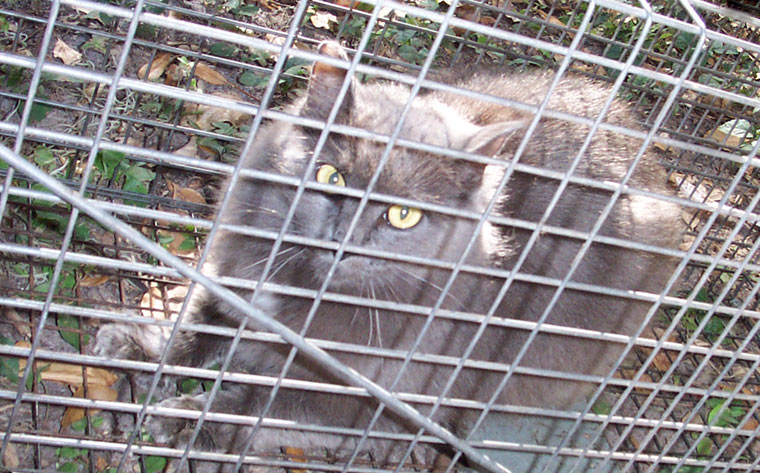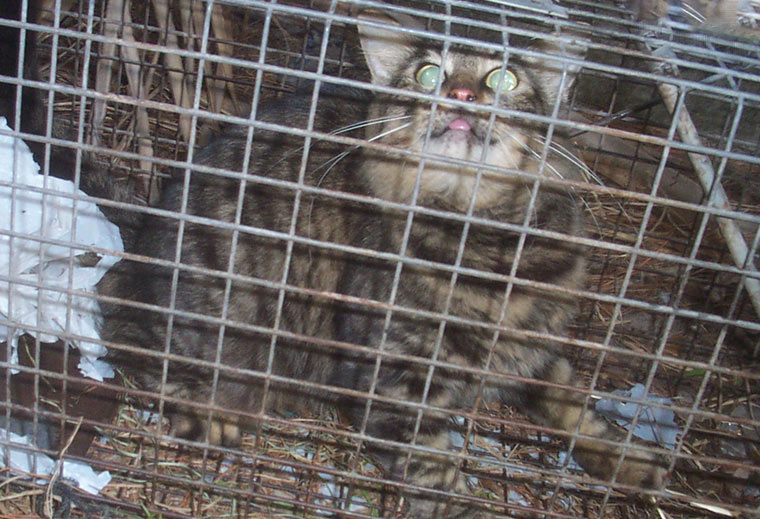-
info@aaanimalcontrol.com
Call us for help in your town
Humane Wildlife Education
Trapping stray cats
Need cat removal in your hometown? We service over 500 USA locations! Click here to hire us in your town and check prices - updated for year 2020.
While it may seem like a very humane thing to take care of stray cats , the truth is that these felines put your family and your own pets at risk. To survive, these cats must often be extremely aggressive, meaning that any other animal that they come in contact with, including people, can be seen as a threat to the animal. This can put in danger and is why you need to make sure that you keep them as far away from you as possible.

There is also the concern that you should have with diseases. Because they are likely not cared for, meaning they have not seen a bat or received the necessary shots, they are likely to carry a number of diseases and parasites that can be extremely dangerous to your own feline. These can lead to such things as distemper, feline leukemia, and worms, all of which can be terminal for your cat to contract. This is why it is important for you to take action to stop these animals from coming around your home.
However, you may find that it is becoming much more difficult to get them to go away. If these cats have discovered some source of food on your property at some point, they may continually return believing they will find it again. This means using techniques to try to keep them away may be completely unsuccessful. You need a different option to be able to take care of the stray cats, and that may mean trying to trap them.
Trapping them and either relocating them or turning them over to animal control may be the ideal option. However, you may have no idea on how exactly should do this. If you are wanting to know how to trap stray cats, here are some suggestions for you.
Where you need to begin is by buying a commercial trap. There are several kinds that you can find out there that allow it to get inside the trap but will not allow it to get back out once it has gotten inside the cage. The door closes, and the cat is trapped.
The key ingredient to making this a success is to ensure that you have a bait that will attract the cat. This is best accomplished by using some kind of cat food, especially something that is from a can. That will lure the cat into the trap where you can have it trapped. Keep in mind that your bait may attract other animals, so it pays to check this on a regular basis.
Once you have captured the cat, your next step is to contact some kind of local professional that can assist you in properly placing the cat in a location where it can survive. Understand that by contacting your local animal control agency that they may suggest that the cat be put to sleep. You may not like that option, but a wildcat can be dangerous to other cats and may be too sick to survive.
How to Trap Stray Cats
Need wildlife removal in your hometown? We service over 500 USA locations! Click here to hire us in your town and check prices- updated for year 2020.
Cats are very well known for being almost impossible trap. That's why you need to do everything you can to make sure a cat trapping mission runs smoothly, and even then, there's a good chance that everything and anything will go wrong.

Most cats are too trap-shy to make this process work, but sadly, trapping, neutering and then rehoming the felines is often the best approach to take to combat the stray and feral cat population of North America. It's a problem that is constantly growing, and because of this, not all resources are available to ensure all trapped stray cats are relocated. Feral cats will generally need to be destroyed, and stray cats that have too poor a temperament, or are too sick, will generally be destroyed also. If the pet is a friendly one, or one who can be easily taught to interact well with people, it can be rehomed. Once again, these kittens will often lead a disappointing life, never finding a forever home. There are not enough people considering adopting these poor, unloved animals.
If you want to try and trap a stray cat to give it the best shot at a good life, you'll need to first allow it to become accustomed to the trap. Do not set the trap, but still continue to bait it, and leave it where you intend to trap the animal. You should do this for a few days, until the cat looks confident enough to wander in and out of the trap freely, and comfortably eat the food that you have left out for it. That's when you set the traps so that they'll confine the animal. If you don't let the cat become accustomed to the trap for a while first, it'll cautiously head towards it, probably set the trap off, and still get away. They're not stupid. There's also a good chance that they have already been trapped and released by somebody before. That's why trapping and releasing wild animals is generally considered to be a bad idea. Those animals become knowledgable about traps, avoid them, and make it very difficult for homeowners and property owners to get rid of them in the future. You will often find that cats will watch other cats get caught up in these traps, and will learn to avoid them that way too. They're not stupid animals, and we definitely don't give them enough credit.
If all else fails, we definitely recommend that you call upon the local city or county animal services, who will usually have a department for cats and dogs, stray or feral. With the rabies concern very real, we need to take all precautions that we can as far as these poor, stray pets are concerned.
For more information, you may want to click on one of these guides that I wrote:
How To Guide: Who should I hire? - What questions to ask, to look for, who NOT to hire.
How To Guide: do it yourself! - Advice on saving money by doing wildlife removal yourself.
Guide: How much does wildlife removal cost? - Analysis of wildlife control prices.
Animals in the attic - read about the common species.
Noises in the attic - how to identify critters by their sounds.


















